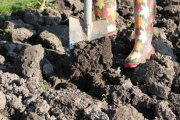Patching a lawn

Holes in the lawn can be caused for all sorts of reasons. Too much traffic, especially at times of drought or extreme wet, can wear the grass out; an over-enthusiastic session with the lawnmower can 'scalp' the grass; or you might have recently dealt with a weed or moss outbreak, leaving weed-free but bare patches behind.
You'll find all you need in our garden centre in Henley on Thames to put things right again, including complete lawn patching kits containing ready-mixed lawn seed mix to use straight out of the bag. Here's how to mend that hole so it looks like it was never there.
- Cut an even square or rectangle around the bare area with a sharp spade, removing remaining turf and topsoil to about 5cm deep.
-
Using a garden fork, loosen the area to about 15cm down, wiggling the fork back and forth to break up compacted soil.
- Fill the hole with topsoil (available bagged from our garden centre) till it's level with the surrounding lawn and mix in general purpose fertiliser such as Growmore. Water lightly.
-
If oversowing with seed: simply broadcast the seed over the top of the patch (for larger areas, mix the seed with silver sand so it flows more easily) and rake in.
- If patching with turf: remove a little more soil to begin with so your topsoil sits a couple of centimetres lower than the surrounding grass, then cut a turf to fit the area.
-
Press the new turf into the area so it's in good contact with the underlying topsoil and tamp in the edges until they sit snugly up against the surrounding grass. Fill gaps with more topsoil.
- For either method, water at least once a day for two weeks, to make sure your new grass doesn't suffer a setback to growth.
-
Cover with clear polythene if the weather is cool, as this will help seeds to germinate and turf to establish more quickly.
- Your new patch will be ready to walk on and mow in another four weeks.
Please ask the staff in our Henley on Thames garden centre for more information and advice about patching your lawn.

